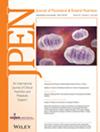Association between protein-energy malnutrition and healthcare use among adult patients after liver transplantation: A retrospective cohort study
Abstract
Background
Protein-energy malnutrition is associated with poor surgical outcomes in liver transplant patients, but its impact on healthcare use has not been precisely characterized. We sought to quantify the burden of protein-energy malnutrition in hospitalized patients undergoing liver transplantation.
Methods
Current Procedural Terminology codes were used to identify United States hospitalizations between 2011 and 2018 for liver transplantation using the Nationwide Inpatient Sample. Patients <18 years old were excluded. Protein-energy malnutrition was identified by International Classification of Diseases Ninth and Tenth Revision codes. Multivariable regression was used to determine associations between protein-energy malnutrition and hospital outcomes, including hospital length of stay and hospital charges/costs.
Results
Of 9856 hospitalizations, 2835 (29%) had protein-energy malnutrition. Patients with protein-energy malnutrition had greater comorbidity burden and in-hospital acuity (eg, dialysis, sepsis, vasopressors, or mechanical ventilation). The adjusted median difference of protein-energy malnutrition vs no protein-energy malnutrition for length of stay was 6.4 days (95% CI, 5.6–7.1; P < 0.001), for hospital charges was $108,063 (95% CI, $93,172–$122,953; P < 0.001), and for hospital costs was $23,636 (95% CI, $20,390–$26,882; P < 0.001).
Conclusion
Among patients undergoing liver transplantation, protein-energy malnutrition was associated with increased length of stay and hospital charges/costs. The additional cost of protein-energy malnutrition to liver transplantation programs was $23,636 per protein-energy malnutrition hospitalization. Our data justify the development of and investment in personnel and programs dedicated to reversing—or even preventing—protein-energy malnutrition in patients awaiting liver transplantation.

 求助内容:
求助内容: 应助结果提醒方式:
应助结果提醒方式:


